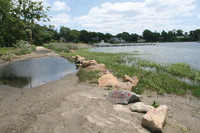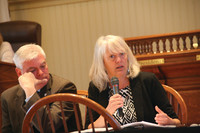The Department of Environmental Management has brought “the hammer down” on Warwick for failing to comply with conditions of a 2008 stormwater management permit, and that’s a good thing in the …
This item is available in full to subscribers.
We have recently launched a new and improved website. To continue reading, you will need to either log into your subscriber account, or purchase a new subscription.
If you are a current print subscriber, you can set up a free website account by clicking here.
Otherwise, click here to view your options for subscribing.
Please log in to continue |
|


The Department of Environmental Management has brought “the hammer down” on Warwick for failing to comply with conditions of a 2008 stormwater management permit, and that’s a good thing in the opinion of many members of the City Council.
After presentations by Mayor Scott Avedisian and DEM Director Janet Coit, the council approved on a vote of 8-0 Monday a consent agreement that requires the city to take a number of steps to identify, monitor and take action to improve the quality of runoff water flowing into wetlands, the bay, streams and ponds.
The agreement was reached by the administration and DEM after months of talks and sets forth a timetable for much of the work to get done.
However, the city is still trying to get its arms around what needs to be done, although, under federal clean water legislation dating back to 2003, it knew it would be required to comply with permit regulations enforced by DEM. At this time the city is still in the process of mapping stormwater outflows, which are thought to number 500 but could be several hundred more. Also, the city is to take dry and wet weather samples from the outflows and conduct tests to determine if they contain indicators of bacteria, phosphorus, and other contaminates. That process is expected to help pinpoint illicit links to the drainage system from residences and businesses as well as hot spots that need to be addressed.
That’s just a piece of the picture.
DEM also identified specific projects aimed at improving water quality, such as the closure of Edgewater Drive that runs along the east shore of Apponaug Cove, that the city must undertake with deadlines for completion of the work. Not all the work is in the field. A lot is to also be done legislatively with ordinances that regulate new developments and set forth monitoring and other requirements. Failure to comply with terms of the agreement can result in penalties and a monthly fine of $500.
The city could have opted to contest the notice of violation, and Avedisian said in opening comments there was friction when he first talked with DEM. Coit said DEM was looking to enforce penalties. But then the parties agreed money would be better spent on bringing the city into compliance than a face-off in the court.
It sounds like the heavy hand of federal and state government. Rather than chafe at the unfunded regulations, council members congratulated Coit for playing hardball. Praise also came from the Buckeye Brook Coalition, the Friends of Warwick Ponds Association, environmentalists, and some of the administration’s persistent critics.
Phil D’Ercole, president of the Warwick Ponds Association, was appreciative that a study will be done of Warwick Pond, the site of a cynobacteria or green algae bloom last summer that forced the pond’s closure to swimming. A study is one of the requirements of the agreement. He questioned whether the agreement could be expanded to include public reports and meetings.
“We must be an integral part of this agreement,” D’Ercole said suggesting quarterly public progress reports.
He got an emphatic “no.”
“We’re not opening this up to amendments,” Coit said.
Noting that agreements are reached through a give-and-take process, D’Erole wanted to know what environmental compromises had been made.
“This is a good agreement to bring the city into compliance,” Coit answered. Avedisian said, “the only thing that moved was the time line.”
In an interview Tuesday, City Engineer Eric Earls, who participated in agreement negotiations, said the city pushed hard to extend deadlines on many requirements knowing that funding and staffing is limited. He considers the agreement aggressive but not unreasonable.
“I don’t see it as a negative,” he said. “DEM allowed us to hit the reset button and given us a schedule to move from here.”
Earls said the $100,000 allocated in the budget with city crews assisting with much of the work should be adequate to meet deadlines over the next fiscal year. But, as he points out, “the clock is ticking.”
At Monday’s meeting, Buckeye Brook Coalition president Michael Zarum likewise characterized the agreement as positive. “It’s never perfect, but a step in the right direction.”
Activists Roy Dempsey and Stacia Huyler focused on what they identified as the city’s failure to take steps, such as street sweeping, that act to stop pollutants from entering the stormwater system. Huyler wanted to know exactly how much had been spent on identifying outfalls and what testing would cost. At one point, Department of Public Works Director David Picozzi angrily grabbed the microphone from Huyler to counter claims street sweeping didn’t start until the summer and the city only has one sweeper. Sweeping started in March this year and the city has three sweepers. Huyler posted a picture of a sweeper on her street in Cowesett on the Warwick Watch Facebook page yesterday morning, with an enthusiastic “wow, can it be?”
“I’m happy this is happening,” Ward 9 Councilman Steve Merolla said Monday. He called on Coit to lobby for state funding, as municipalities “are strapped.”
Ward 4 Councilman Joseph Solomon applauded the agreement and the action to work cooperatively.
“We have kicked the can down the road and we can’t continue to kick it. Thanks to DEM for dropping the hammer. We’re going to address the issues,” Ward 5 Councilman Ed Ladouceur said.
Reached on Tuesday, Ladouceur said, “this is no celebration…now, we’re forced to do something.”
Ladouceur said he has “all the confidence in the world” that Picozzi and the Department of Public Works can do much of the work.
“If David says he can, my money is on David,” he said.
Ladouceur also said he’s open to additional funding should it be needed.
In addition to the abandonment of Edgewater Drive for an $8,000 credit, the agreement identified five other projects that can generate credits that can be used to offset penalties should they be incurred. Those credits and the projects are: $100,000 for the removal of a concrete foundation in the area of the filled-in Rocky Point saltwater pool; $70,000 for 10 solar-power trash compacting receptacles at Oakland Beach, which would be leased; $40,000 for the Buckeye Brook waterway study, including an examination of increased water levels at Warwick Pond; $8,000 for abandonment of the Midgely Avenue roadway along Mary’s Creek; and $5,000 for a Lippitt School rainwater garden demonstration project. Failure to complete these projects on time could result in the loss of the credits and possible penalty.
2 comments on this item Please log in to comment by clicking here
Edgar42
This has been a problem for years. It's about time!
Friday, June 10, 2016 Report this
Stacia24
Picozzi said he had THREE street sweepers, not one. The taxpayers just bought another street sweeper for $204,000
Friday, July 1, 2016 Report this